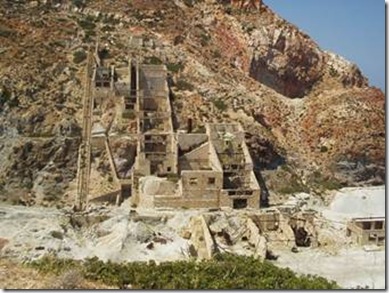Although I blogged about it at the time nearly two years after the fact I have finally written an article about our trip to Milos in June 2009 and created a web page for Milos. This is part of my trend to provide personalized travel guides for the places that we have been.
As experienced Greek island hoppers we were not quite prepared for Milos. As our ferry powered into a large open harbour the vista was of hilltops broken with mining scars. The port town of Adamas sprawled up a hillside with remnants of industry here and there on the fringes. When we were in the town everything appeared dusty. In certain places on the island we would get a whiff of sulphur. Yes, Milos was noticeably different and has a unique history due to its geology.
During our three days there we grew to love that diversity and found many intriguing places to visit. The islands Mining Museum is a new building full of interesting old stuff and a fascinating display of minerals. Over the years many different products have been mined. We wanted to find the abandoned sulphur mine because we had heard stories about how strange it was.
The visit was a haunting experience even eerie, you would have to be there to know what I mean. The buildings (many not shown in the photo) had a heavy, slightly sinister feel to them.
We also enjoyed several beaches as we toured the island on our motor scooters. These included Firiplaka and Provatas. The most starkly unique was Sarakiniko; like a lunar landscape yet unreal. Very white convoluted rock formations reach out towards the sea as if a monumental sculpture.
Below the central towns of Tripiti and Plaka are ruins of an old Roman city. On the way there we stopped at the cave where the famous ancient sculpture Venus de Milo was discovered in the 18th century. This statue, by the way is carved in marble from our home island of Paros. Also near here are ancient Christian catacombs where the early, persecuted Christians secretly buried their dead.
Our other side trips included Klima where the houses butt up to a hillside with boathouses in caves below them. While we chose the central town of Adamas for our stay the village of Pollonia especially impressed us. It reminded us of our home village, Aliki, Paros.
Another highlight of our Milos visit was a meal at the O! Hamos taverna (O! Xomos in Greek, means The Mess). We have never seen anything like it in Greece for charm and character. It was funky, had writings on the walls and chairs and lovely pottery cups to drink our ouzo from. Then we were pleasantly surprised by friendly, efficient service and to top it off, the food was great. I strongly advise any island hoppers who are getting tired of the traditional taverna to make a point of discovering this place at the edge of Adamas. As it is right on the beach, we ate, walked across the street and swam and laid in the shade. It’s worth writing home about!
Milos is certainly not your typical Greek island for sea, sand and sun but we highly recommend it for its unique character and style. Since it is on a different ferry route than the main Cyclades of Paros and Santorini it is less busy and more of a Greek experience. Yet for most of the year there are daily ferries between Athens/Piraeus and Milos. This route usually includes stops at Serifos, Sifnos and Kimilos; all attractive little islands. There are also flights from Athens. Greek island hopping is a fun travel adventure, dive in.
Next I will update the Sifnos portion of the trip. In the meantime you can see Karin’s photo journals starting HERE
![clip_image002[8] clip_image002[8]](http://lh3.ggpht.com/_1JLEFVhDuYs/TaWzRzT-O7I/AAAAAAAAN7g/891xz5AjnIU/clip_image002%5B8%5D_thumb%5B1%5D.jpg?imgmax=800)
![clip_image002[10] clip_image002[10]](https://blogger.googleusercontent.com/img/b/R29vZ2xl/AVvXsEhlg5Udgqti71S8R-nKoqVu-yCbt_YmANAPk167Qh-1b1ML9RczPDZDyJq4ymNACXZVEHwzWT-MeuVurx8kVxWz-xny89K8MhXZ6aRbpjqtlgRWOD4zh3Jd0ET_fe6SpL740DZXkQ/?imgmax=800)
